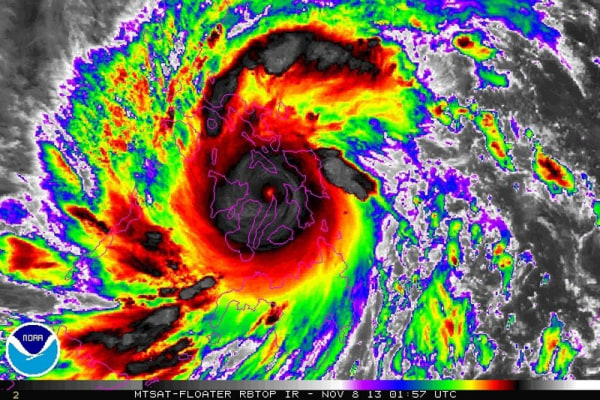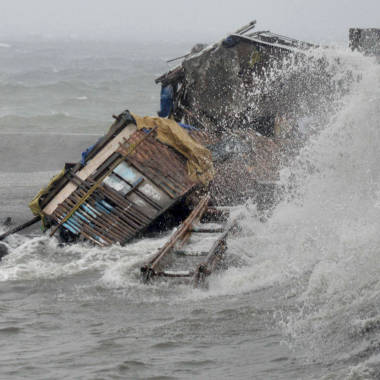Experts said Haiyan is the strongest typhoon of the year and possibly the most powerful to ever hit land.
By M. Alex Johnson and Alexander Smith, NBC News
The scope of the most powerful storm ever to make landfall was slowly revealing itself Saturday as dawn broke over the Philippines, where at least four people were confirmed dead after super Typhoon Haiyan swept the Pacific islands.
The typhoon generated nearly 200-mph winds as it rampaged through on Friday. At 4 a.m. (3 p.m. Friday ET), its top winds had lessened to 110 mph — after having approached 195 mph at landfall Friday morning — and its center had cleared the country and was about 250 miles west of San Jose.
Along the way, it cut off many of the country's lines of communication, leaving the extent of its damage a mystery overnight.
Early Saturday, the national disaster agency confirmed four deaths and said four other people were missing. Hundreds of homes were flattened and almost 800,000 people had been evacuated to emergency shelters as Haiyan triggered mudslides, flash flooding and a storm surge with waves of up to 30 feet Friday.
But forecasters and government officials said a much more devastating toll could emerge once daylight made it easier to move around.
"It is the most powerful storm ever to make landfall," Michael Palmer, lead meteorologist for The Weather Channel, told NBC News. "It is as strong a typhoon as you can get, basically," with winds able to "obliterate poorly constructed homes."
Authorities warned that 12 million people were at risk, including about 2.5 million in Cebu City, as well in areas still recovering from a deadly 2011 storm and a 7.2-magnitude quake last month.
"Thousands of people are likely to be left without food, shelter and water," said Bernd Schell, the Philippines representative for the International Federation of Red Cross and Red Crescent Societies. "This is a double blow for the survivors of the earthquake in Bohol and Cebu, who were already struggling to get back on their feet."
Dale Eck, director of The Weather Channel's global forecast center, said the strongest winds had lingered over the Philippines only for two to four hours, meaning "the duration of the extreme winds was short."
"But it will be pretty nasty damage," he said.
More than 100 coastal homes were flattened and landslides destroyed houses in the hills in Southern Leyte province, Gov. Roger Mercado told DZBB radio of Manila.
"We lost power, and all roads are impassable because of fallen trees," he said. "We just have to pray."
Palmer of The Weather Channel said gusts of 220 mph had been recorded. "That is the equivalent of EF4 tornado winds — even EF5," he said. "You would not be able to stand up. It would knock you off your feet and blow you away."
Even so, Palmer warned that the storm surge presented the most danger. "Usually, that's what causes the most death and destruction," he said.
The storm surge flooded the town of Palo in Leyte province under 10 feet of water, the official government news agency, PNA, said Saturday. It said emergency officials were working to confirm local television reports that about 20 people drowned.
Transportation was deadlocked, with roads across the country rendered impassable.
Thirteen airports were closed and 118 domestic flights were canceled, the Civil Aviation Authority said Saturday morning. Almost 3,400 passengers on 76 sea vessels were stranded in port as they tried to ride out the storm, the national disaster said.
Meanwhile, evacuations were already under way in Vietnam and Laos, where Haiyan was projected to hit next. Meteorologists in Vietnam said it could be the country's strongest storm ever.
Elizabeth Chuck of NBC News contributed to this report.

NOAA via Reuters
Typhoon Haiyan in a NOAA satellite image Friday.
Related:
This story was originally published on Fri Nov 8, 2013 5:16 AM EST

Tidak ada komentar:
Posting Komentar